2023 ANNUAL REPORT











highlight the important work you so generously support.
This 2023 Annual Report is a summary of the efforts of the dedicated Western Pennsylvania Conservancy team to protect our region’s most important places. None of it would be possible without your help and support!
Our significant 2023 land protection outcomes helped safeguard rivers and streams, protect large forests, and conserve habitat for our region’s native species. And we are pleased to have established a new nature preserve, thanks to the generosity of the Babcock family, which has been a part of the Conservancy’s history since its founding in 1932.
In 2023 our watershed team continued its work to address the effects of agricultural impacts, abandoned mine drainage and sediment from dirt and gravel roads on our region’s watersheds. More than 32 stream miles were restored in 2023. In addition, we planted thousands of native trees, plants and grasses near river and stream banks to improve and protect water quality.
The Western Pennsylvania Conservancy protects and restores exceptional places to provide our region with clean waters and healthy forests, wildlife and natural areas for the benefit of present and future generations. To date, the Conservancy has permanently protected more than 285,000 acres of natural lands. The Conservancy also creates green spaces and gardens, contributing to the vitality of our cities and towns, and preserves Fallingwater, a symbol of people living in harmony with nature.
Our community greening work, with its so many volunteers, brightens neighborhoods with beautiful gardens, trees and landscapes, and provides environmental benefits such as reducing stormwater runoff and providing pollinator plants. Together, this work provides so many benefits to our communities across the region.
At Fallingwater, a large-scale initiative to address the preservation of Fallingwater’s major building systems progressed in 2023. We also provided new and expanded educational programs and learning experiences at Fallingwater through tours and Fallingwater Institute programming. Visitors and participants who explore the house and landscape are always encouraged to reflect on Wright’s approach to architecture and the natural setting.
We hope you enjoy this report. Thank you for your dedication and support for tangibly advancing conservation in our region in so many ways.

Thomas D. Saunders PRESIDENT AND CEO

48 acres of riparian trees planted
8oo live stake trees planted at Lower Elk Creek Nature Reserve
3,079 acres permanently protected and saved for nature and future generations
990
Pounds of trash removed from four WPC preserves along French and Cussewago creeks during the 2023 French Creek Watershed Clean-up
4,468 youth and adult learners participated in various Fallingwater Institute and other Fallingwater education programs
221 volunteers helped implement watershed conservation projects
Alfred Barbour
David Barensfeld
Franklin Blackstone, Jr.*
Barbara H. Bott
E. Michael Boyle
Marie Cosgrove-Davies
Beverlynn Elliott
Donna J. Fisher
Susan Fitzsimmons
Paula A. Foradora
Dan B. Frankel
Dennis Fredericks
Felix G. Fukui
Caryle R. Glosser
Carolyn Hendricks
Thomas F. Hoffman Sanjeeb Manandhar Robert T. McDowell
J. Mooney Daniel S. Nydick
Stephen G. Robinson Samuel H. Smith
940 trees planted with the help of 699 volunteers in communities through TreeVitalize Pittsburgh and our other community forestry programs
7oo encounters with wood turtles during population surveys at 74 stream segments in PA during a two-year grant period
6,894 volunteers planted
130 community flower gardens

culverts. This important work is accomplished thanks to the dedication, collaboration and hard work of many partners, landowners, volunteers and staff, and the support of our members.
For years, the eroding streambank along Elk Creek in Erie County caused sedimentation and pollutants to enter the stream and presented a safety hazard to anglers and other outdoor enthusiasts. An extensive Elk Creek restoration project in 2022 included the strategic placement of a 600-foot-long stone stabilization wall and eight in-stream weirs to control erosion.
During summer 2023, as part of the development of a Pennsylvania Department of Conservation and Natural Resources Rivers Conservation Plan for the Girty’s Run watershed, WPC completed extensive surveys to outline possible freshwater mussel habitat downstream and upstream of the Girty’s Run delta, within the Allegheny River near Pittsburgh. A delta is a flat, low-lying area that forms at a river’s mouth from sediment deposits.
Few jobs require hip boots as standard attire, a mastery of chainsaws or SCUBA gear at the ready. With river bottoms, forests and farmland for offices, our watershed conservation team conducts freshwater mussel surveys, strategically places woody materials in streams and works with landowners and partners to plant trees along rivers. In 2023, we restored or improved 32 stream miles throughout the region. It takes a community working together to ensure great water quality and wildlife habit: 221 volunteers helped to plant riparian trees, implement large woody restoration projects and more.
Dams, undersized culverts and sediment are no friends to fish, hellbenders, mussels and other aquatic organisms. The obstructions hinder stream dwellers’ ability to move freely through sections of a stream, limiting their health and breeding opportunities, which leads to genetic weaknesses and diseases.
Aquatic organism passage projects remove a barrier or improve infrastructure so aquatic organisms can move freely upstream and downstream, leading to improved health and a diversified population. In 2023, WPC’s watershed conservation team removed 10 barriers, including dams and undersized culverts, to improve aquatic organism passage and reconnect 12 miles of stream. For example, in the Middle Fork watershed on PA State Game Lands 25 in Elk County, we partnered with the PA Game Commission and Elk County Conservation District to remove a culvert and replace it with a wildlife friendly, stabilized-ford stream crossing.
In Cameron County on State Game Lands 14, we partnered with PGC to replace two undersized culverts with timber deck bridges, with funding from the PA Fish and Boat Commission, improving steam passage for trout, turtles and other aquatic species to two miles of coldwater habitat.
The Conservancy’s decades-long work to improve water quality in the Allegheny National Forest, including in-stream restoration, dam removals and riparian plantings, garnered a national award for our Watershed Conservation program! At the National Rise to the Future Award ceremony in Washington, D.C. Watershed Manager Kylie Maland, Watershed Project Manager Luke Bobnar and Senior Director of Aquatic Sciences Eric Chapman accepted the U.S. Forest Service’s Partnership Award on behalf of the Conservancy’s longstanding watershed work in the ANF and the Allegheny Watershed Improvement Needs (WINs) Coalition.
The ANF staff nominated the Conservancy for the award, noting that WPC has been one of ANF’s strongest watershed restoration allies for nearly 20 years. In the ANF we have installed in-stream restoration projects to mitigate flood risks, slow erosion and improve floodplain connectivity, and planted riparian trees, conducted aquatic surveys, and removed dams and replaced
In spring 2023, staff and 14 volunteers planted 800 live stakes of trees to further stabilize the streambanks along Lower Elk Creek at our Lower Elk Creek Conservation Area in Erie County. Live stakes are tree branches cut while the trees are dormant then planted directly in the soil. They grow into new trees that help stabilize the streambank and filter pollutants from entering the stream.
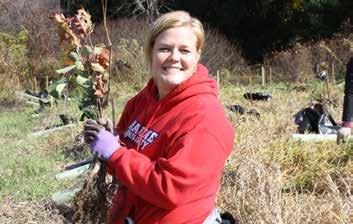
WPC Watershed Forestry Specialist Danielle Rihel received the Outstanding Watershed Individual of 2023 award from the Armstrong Conservation District, a Certificate of Recognition from the PA Senate, and a Watershed Conservation Award from the U.S. House of Representatives. Passionate about improving the ecological function and water quality of PA’s rivers and streams, Danielle also implements plantings that convert lawns to forests or meadows.
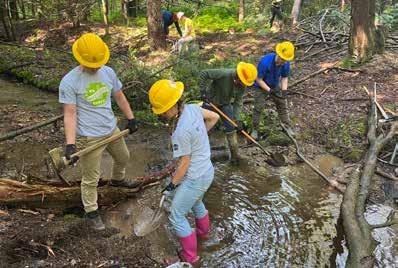
Through bathymetry mapping, a depthmapping method that measures and records the shape of a river bottom, WPC staff determined river depths at the delta, which helped to identify potential mussel habitat. Then they collaborated with the Pennsylvania Department of Environmental Protection to identify locations for mussel surveys. WPC and DEP divers surveyed four locations for freshwater mussels downstream and upstream of the Girty’s Run delta, collecting 91 freshwater mussels representing nine species common in Pennsylvania. The appearance of several juvenile mussels shows that new arrivals find the habitat suitable—a positive sign of river health!
Fish in Bedford, Centre, Cumberland and Franklin counties will enjoy cleaner, healthier homes, thanks to DEP Countywide Action Plan grants we received during 2023. The grants will fund water quality improvement projects, including streambank restoration, to help Pennsylvania reach its Chesapeake Bay Plan watershed improvement goals. By decreasing sediment and nutrient pollution to local streams, the projects should improve instream habitat.
We’re continuing to improve the Juniata watershed, also. During the past 25 years, the Conservancy has partnered with conservation organizations, local government agencies and
Nearly 60 volunteers, including those from PA DCNR’s PA Outdoor Corps and Youth Conservation Corps, and community partners contributed 376 hours to help us improve water quality and stream ecosystem health on more than 13 miles of stream habitat in three watersheds in the Allegheny National Forest! We partnered with the U.S. Forest Service, PA Coldwater Heritage Partnership and Warren County Conservation District on the project, funded by the National Forest Foundation.
the public to improve water quality in the Juniata watershed, which encompasses 3,400 square miles and includes all or parts of 12 counties. Together, we’ve planted trees, removed stream barriers and reduced agricultural nutrient runoff.
In 2023, 29 community members attended three public meetings to provide input on the updated Juniata Watershed Plan, “Juniata Forward: Building on 25 Years of Conservation,” funded by PA DCNR. Discussion centered around recreation, historic preservation and development on the river. An online survey garnered responses from 76 residents. The plan builds on a PA DCNR Rivers Conservation plan written in 2000.

WATCH our free 2023 webinar, “Helping Elk Creek Thrive: Our Decades Long Commitment to a Local Treasure,” about our efforts to restore Elk Creek.
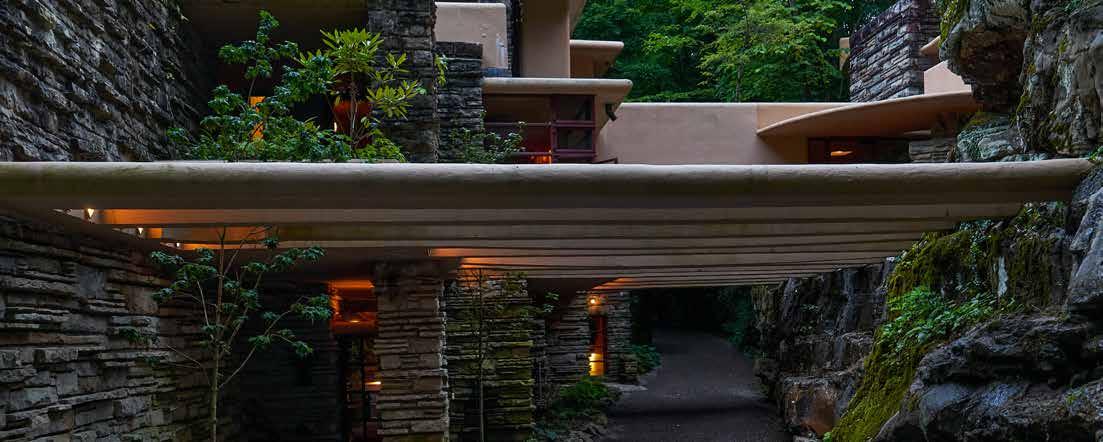
Fallingwater entrance at dusk
Every year, Fallingwater staff strives to fulfill a promise the Conservancy made to the late Edgar Kaufmann jr., who said of Fallingwater, “The union of powerful art and powerful nature into something beyond the sum of their separate powers deserves to be kept living.” 2023 marked the Conservancy’s 60th consecutive year of welcoming people from around the world and from all walks of life to experience this remarkable architectural and cultural gem.
Through tours, special programs, workshops, exhibitions and more, many activities helped advance Fallingwater in 2023, but none more urgent than the preservation of Fallingwater’s major building systems. “Historic building preservation isn’t a one-size-fits-all approach, and each building comes with its own set of unique challenges,” says Fallingwater Senior Director of Preservation and Collections Scott Perkins, adding, “Preventing further water damage is one of ours.” Scott is leading the three-year effort to preserve Wright’s crown jewel of organic architecture.
Work started in February 2023 on our World Heritage Preserved initiative
as conservators removed some of the built-in furniture in the Guest House, Edgar jr.’s Study and Edgar Sr.’s Dressing Room and Study to expose the stone walls for mortar work and testing.
Soon after, our maintenance team assessed cracks in Fallingwater’s chimney walls, repointing portions of the deteriorated mortar to repair cracks. Mortar specialists from Graciano, a Pittsburgh-based masonry firm, tested for the presence of water and considered various grout-injection options to address current and future water leaks and damage.
“This meticulous work is one of the best strategies to prevent the movement of water within the voids between Fallingwater’s interior and exterior stone walls,” Scott says. The work also involved matching existing mortar in both color and composition. Work on the Guest House’s steel frames also advanced.
Pamela Jerome, president of New York City-based Architectural Preservation Studio, is the lead architect overseeing the preservation work. She has been involved in various aspects of Fallingwater’s preservation
for more than 30 years. Her team is advancing the grout injection and masonry work and replacing waterproofing membranes on the Guest House roof and East Terrace that took place in late 2023.
To keep supporters and visitors up to date on preservation activities, we launched a blog that provides monthly updates, complete with photos, videos and short descriptive overviews of progress. Visit the blog at: Fallingwater.org/projects/worldheritage-preservation.
Fallingwater Fireside, which features in-person discussions in the Living Room, launched in 2023. Artist and sculptor Bryan Hunt, Grammy Awardwinning cellist Mike Block and architect Daniel Libeskind were the inaugural featured speakers for the series. Each sold-out event started with a cocktail reception followed by conversation and discussion.
Conservancy Vice President and Fallingwater Director Justin Gunther created and facilitated the program. “We frequently hear how professionals and artists are inspired by Fallingwater, and this series offered a window into how their experiences
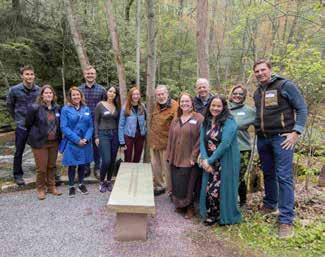
George Longenecker (center, in brown coat), who passed away in 2023, left an indelible mark as the landscape architecture intern advisor to Fallingwater for nearly 40 years. Before his passing, we installed a bench to honor him, and held an event that was attended by former landscape interns.
with the site fostered new perspectives and discoveries,” he shares. Register for the 2024 fireside discussions at Fallingwater.org/ fallingwater-fireside.
Thousands of visitors experienced Fallingwater in 2023 through tours and other experiences that inspired imaginative thinking. A new exterior tour, Guided Grounds Walking Tour, led by our educators, provides insights into the Bear Run landscape. This new tour broadens a sense of discovery for many visitors, including for Cassandra White, who says it was “transformative” to experience the natural surroundings of Fallingwater.
“You hear so much about Fallingwater that you forget about how the landscape influenced this design, and this tour really helps to shape that understanding,” says Cassandra.
Fallingwater Institute participants who experienced Fallingwater in 2023 gained a deeper appreciation of architecture and design as well. Fallingwater Senior Director and Curator of Education Ashley Andrykovitch says many embraced the journey of discovery the courses provide.
“Interest in 2023 high school and college residency programs and workshops was equal to prepandemic levels,” Ashley says. “I think people are eager to gather and be in community with others. The collaborative format of many Fallingwater Institute programs helps to share a more inclusive and richer understanding of Wright’s design.”
The Japanese floral artform, ikebana, provided even more natural beauty and interest inside Fallingwater in 2023 through a special installation of modernist arrangements, called Elements of Balance by Sogetsu Pittsburgh.
Sogetsu Pittsburgh, an organization that hosts a collective of artists studying and displaying ikebana, partnered to become Fallingwater Institute Artists-in-Residence to study the

landscape and consider interdisciplinary possibilities of ikebana where craft, art, architecture, nature and composition harmonize. During their residency, they worked closely with Fallingwater Horticulturist Emily Sachs to consider the vegetation and flora for their arrangements. They also conducted a workshop on floral arrangements for Fallingwater staff and volunteers.
Sogetsu also celebrated the important regional legacy of ikebana by including historic vessels in the installation on loan from the Katherine Mabis McKenna Foundation, from the collection of Kay M. McKenna, Greensburg-based ikebana artist and founder of Ikebana International Pittsburgh Chapter established in 1959.
The Sogetsu group was one of three Fallingwater Artists-in-Residence in 2023, some of which were returning artists and scholars. Those included Félix de la Concha, who revisited for plein air paintings, Emma Baiada, who continued work on a video artwork that provides a behindthe-scenes look at Fallingwater staff, and Dr. Barry Kerzin, who offered a meditation workshop for staff.

However, many species still face threats such as habitat loss, invasive species and climate change.
Our Pennsylvania Natural Heritage Program biologists are assessing 1,400 invertebrates for the PA 2025-2035 State Wildlife Action Plan, a blueprint for conserving fish and wildlife and preventing species from becoming endangered. We’re evaluating rarity, threats, conservation actions and habitats, and are researching, surveying and monitoring needs for those determined to be Species of Greatest Conservation Need.

Nearly 170 volunteers helped our PNHP staff complete a wetland monitoring project that will allow the community to engage with vernal pools for years to come at two state parks, Gifford Pinchot State Park and Kings Gap Environmental Education Center. The volunteers led vernal pool walks, participated in phenology monitoring and installed community science stations. GIANT’s “Healing the Planet” funding supported the project.
Our conservation scientists slog through wetlands and rivers to document invasive and endangered plants and animals, trek through nighttime forests in search of treedwelling salamanders and analyze data to create comprehensive databases and GIS maps. Scaling cliffs and crawling through caves, they study Pennsylvania’s ecosystems and species, and document new discoveries and population changes. This work supports the conservation and stewardship of our region’s biodiversity.
2023 marked 50 years since the federal Endangered Species Act was enacted to provide a framework to conserve and protect endangered and threatened species and their habitats. Some species in Pennsylvania have rebounded, including the bald eagle, which spent 29 years facing extinction. Delisted in 2007 thanks to collaborative efforts by federal, state and local organizations and the support of concerned citizens, this majestic bird once again nests in Pennsylvania’s forests and soars along river valleys.
Groups being assessed include snails, butterflies and moths, dragonflies and damselflies, stoneflies, tiger beetles, longhorn beetles and other beetles, craneflies, grasshoppers, crickets, mayflies, spiders and more. These groups have been traditionally underrepresented in conservation assessments.
A delicate butterfly native to Pennsylvania, the West Virginia white once ranged through a significant portion of the state. Populations have decreased, mostly due to the spread of exotic invasive garlic mustard—a toxic decoy to the butterfly’s main source of nourishment, the native two-leaved toothwort. When the butterflies lay their eggs on garlic mustard, their caterpillars always die.
The rare butterfly is just one of our state’s many native species threatened by invasive species, says Brian Daggs, the Conservancy’s invasive plant ecologist with PNHP.
Invasive species non-native species that do not occur naturally in an area and grow quickly and aggressively out-compete native species for food, habitat and other limited resources. A leading cause of biodiversity loss worldwide (after habitat loss), invasive species can cause the extinction of native plants, animals, fungi and microorganisms.
“When an invasive species finds itself in our native habitat, it is set free from its natural competitors, pests, predators and pathogens,” Brian explains. “So it has the competitive edge.”
Unfortunately, invasive species are entrenched in our region’s habitats and endanger the biodiversity of ecosystems, and the goal is not to eliminate them as much as to control their reach and damage.
To combat them, Brian says, WPC participates
After an illustrious and adventurous 43-year career, Charles Bier, the Conservancy’s senior director of conservation science, retired in December 2023. He started his career at WPC in 1981, alongside his wife, Terry, as a caretaker, nature steward and naturalist educator at Fallingwater and Bear Run Nature Reserve. A year later, he arrived at our Pittsburgh office to work as a botanist, zoologist, ecologist and data processor. Charles helped to establish the Pennsylvania Natural Heritage Program and conducted more than 1,000 field surveys, documenting more than 1,500 occurrence records that are foundational to the 30,000+ records in the PNHP database. He devoted his career to studying, caring for and interpreting our region’s natural history, biodiversity, conservation needs and the impacts of climate change on native flora and fauna. He plans to volunteer with WPC.
in education and public engagement, especially through the iMapInvasives invasive species scavenger hunt each August (PAiMapInvasives.org/events); statewide partnerships to coordinate invasive species management; on-the-ground surveys for invasive species; and the Governor’s Invasive Species Council, which identifies invasive species that could threaten PA’s natural and agricultural resources.
PNHP ECOLOGIST DISCOVERS SWAINSON’S WARBLERS BREEDING IN PA
Shy birds that forage in the leaf litter of the forest floor, Swainson’s warblers are often heard but not seen. In July 2023, WPC’s PNHP Avian Ecologist David Yeany and Bird Lab Executive Director Nick Liadis discovered the first breeding occurrence of Swainson’s warbler in Pennsylvania at Bear Run Nature Reserve! It is the northernmost breeding record for the species. Avian ecologists continue to collaborate to create plans for its conservation.
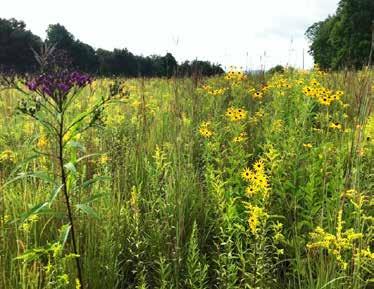
We reseeded 43 acres of native wildflower meadows at Bear Run Nature Reserve in Fayette County. The area is former farmland we transitioned several years ago to grow goldenrod, purple coneflower, marsh blazing star and other species. The perennial flowers provide food and shelter for pollinators and help improve soil quality, filter nutrients and build resiliency against climate change and invasive species.
Our land stewardship staff and volunteers work to sustain our 44 nature preserves’ ecological value and improve accessibility so everyone can enjoy nature. Year round, in weather ranging from snow to summer heat, our staff monitors the 15,300 acres we own and manage, as well as 41,188 acres on 222 privately owned properties with conservation easements. A few of staff’s many responsibilities include meeting with easement property owners and walking their properties, as well as caring for WPC preserves, with tasks that include maintaining trails, tree-planting sites, parking areas and signage, and walking preserve boundaries.
Land stewardship volunteers are vital to our work. In 2023, 71 volunteers contributed 835 hours to removing invasive plants, building trails and clearing preserves of debris.

At our Helen B. Katz Natural Area in Crawford County in 2023, we completed a 40-acre wetland restoration at an area that had been drained to support agriculture. We removed drain tile, creating two wetland depressions one of which immediately filled
with water! planted native vegetation and treated exotic invasive plants. We’re excited to see the wetland develop over time.
Next to a small parking area at Katz, we planted native grass and a wildflower seed mix with oats as a cover crop to manage soil erosion, weeds, pests and diseases, among other things on one and one-quarter acres. In a few years, the preserve will bloom with little bluestem, wild bergamot, black-eyed Susan, butterfly milkweed, New York ironweed and other native wildflowers to support pollinators.
To restore forest in a riparian area (near a stream) next to a former pasture at our Wolf Creek Narrows Natural Area in Butler County, Slippery Rock University students planted native shrubs and trees, including pin oak, black chokeberry, silky dogwood and sugar maple. The students gained valuable experience in ecological restoration.
With forests, streams, wetlands and open meadows in 16 counties, near cities, towns and rural areas, our now44 preserves offer a variety of outdoor experiences! Thanks to 789 donors who generously responded to our “41 Places: Nature Near You Needs You” fundraising campaign in 2021 and 2022, we received $632,000 to improve the preserves we own and manage across Western Pennsylvania for all to enjoy!
In 2023, staff and volunteers continued to remove past traces of damage to land, control invasive species and maintain welcoming trails, signage and parking. We’ve completed or are currently completing 54 projects funded by the campaign, and have acquired equipment, supplies and a new vehicle necessary for our work.
In 2023, we constructed or enhanced seven parking lots at preserves, including at our 630-acre Dutch Hill Forest and two other WPC preserves in the Clarion River region and our 376-acre Sideling Hill Creek Conservation Area in Bedford and Fulton counties.
Also at Sideling Hill, we removed two structures to return the landscape to a more natural state. At our 582-acre Lake Pleasant Conservation Area in Erie County, we finished removing two large structures.
LEASING WPC LAND FOCUSES ON AGROFORESTRY
is a compact operation. Through the Conservancy’s Farmland Access Initiative, Dylan Heagy and his wife, Chesley, lease the 26-acre farm to produce honey, pork, eggs and vegetables grown without pesticide or herbicides for distribution in the Pittsburgh region.
The farm’s focus, however, is increasingly on agroforestry, specifically silvopasture farming: the integration of trees with grazing animals to create a managed woodland pasture. Dylan says the hundreds of trees they planted in 2023—and the 1,000 trees and shrubs they plan to plant in 2024—serve multiple functions, including supporting a herd of cattle they are developing for future beef production.
“Our silvopasture system integrates animal grazing with tree cultivation, which enhances land use and animal welfare,” he says. Cultivating berries, apples, nuts and other perennials will provide sustainable food sources for humans. And, he notes, “The diversity of plant life contributes to soil health, water conservation and wildlife habitat, aligning with our goals of environmental stewardship.”
Dylan’s knowledge of and passion for agroforestry led to a staff position with PASA Sustainable Agriculture, where he helps to coordinate and develop agroforestry efforts for the Northeast and Mid-Atlantic regions of the U.S., with a focus on developing a training program. WATCH our 44-minute film: “Seeing The Unseen: Aquatic Invaders & What’s at Stake,” about the negative impacts of aquatic invasive species on the Lake Erie watershed and surrounding areas.
Still Wagon Farm in Ruffs Dale, Westmoreland County,

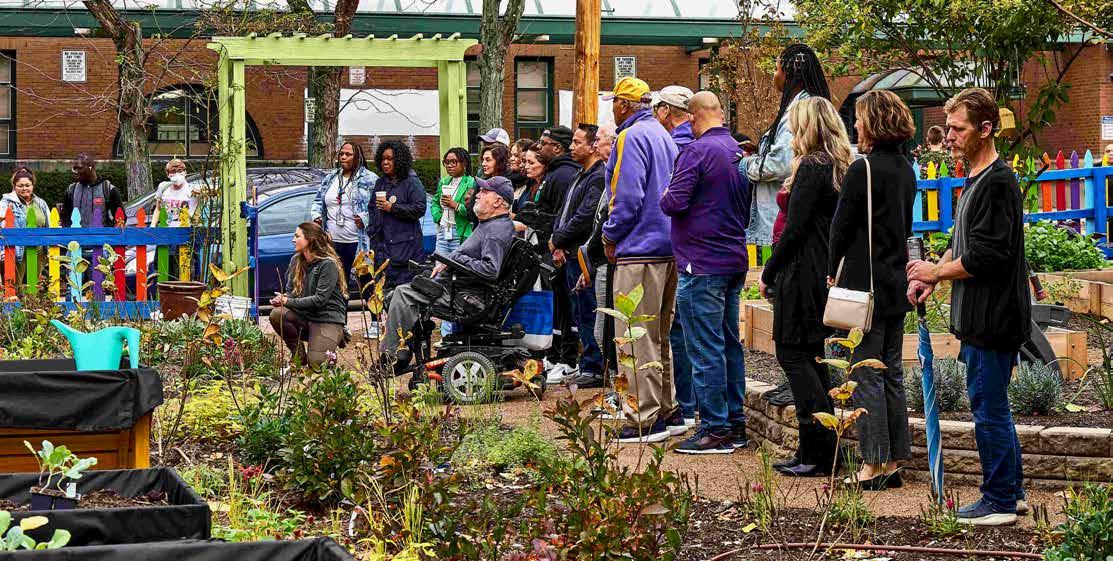
was another successful year for the Conservancy’s community greening team, thanks in part to the many volunteers, partners and funders who help green and beautify communities across Western Pennsylvania.
STUDENT LEARNING THROUGH STEM AND THE NATURAL ENVIRONMENT
“A sense of adventure, nature and exploration makes learning more memorable and impactful,” says Kelly Flynn, education and special projects coordinator. A former teacher, Kelly works with other staff to install and improve nature-based outdoor learning and play spaces at local elementary schools and early childhood centers in the region.
The Conservancy advanced this work at several school sites in 2023, including creating two new outdoor spaces that provide teachers with numerous opportunities to incorporate learning related to STEM and the natural environment into school instruction.
A new outdoor classroom at Laurel Valley Elementary School in New Florence, Westmoreland County includes an ADA-compliant pathway that connects to the school building to help students of all abilities utilize the new greenspace. The greenspace, which opened in May 2023, also has a teaching shed with white boards, six child-sized picnic tables and four flower-shaped chalkboards. Eight trees and 26 pollinator-friendly perennials and shrubs provide the natural surroundings.
A ribbon cutting event also took place for a new outdoor play area for students from Pittsburgh Public Schools’ Chartiers Early Childhood Center. The play area was built thanks to funding from PNC Foundation’s Grow Up Great initiative. Twenty students were among the first to explore their natural surroundings in the new space, which encourages motor skill development, nurtures creativity and stimulates curiosity. The site includes 19 native trees, 14 shrubs and 60 pollinator-friendly perennials. In addition, the outdoor space features ADA-accessible pathways, picnic tables, benches and 122 stepping stones.
Conservancy staff sought input from teachers about how they would use the space and the types of vegetation to plant and elements to install. “Teacher and administrator feedback is crucial for understanding how students learn and interact with these spaces,” Kelly says, explaining, “That’s why we do the work this way; we want the students and teachers to see the value of these spaces created to meet their needs.”
Our tree-planting efforts got significant funding support in 2023. Pittsburgh Canopy Alliance, in
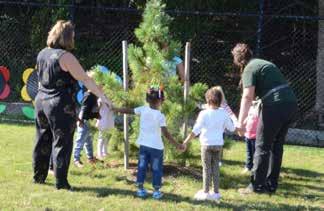
School children play and learn in their new outdoor classroom at Pittsburgh Public Schools’ Chartiers Early Childhood Center. The space includes 19 trees, 14 shrubs and 60 perennials to encourage motor skill development, nurture creativity and stimulate curiosity.

This volunteer tree planting event in Johnstown was one of 47 community tree plantings in 2023, when a total of 940 trees were planted in Western Pennsylvania communities.
which the Conservancy is a partner, received an $8 million grant from the U.S. Forest Service to improve the urban tree canopy in underserved and unrepresented communities in Allegheny County. The Conservancy will receive $600,812 from that grant for community forestry work in the region.
These funds will support community planning and developing the workforce to plant and maintain trees along streets, in parks and public greenspaces, and residential and institutional properties, all within Allegheny county Justice40 Zones—economically distressed areas vulnerable to the effects of climate change.
This funding is significant,” says Director of Community Forestry and TreeVitalize Pittsburgh Jeff Bergman. With their many benefits, planting more trees is an effective solution to many of our environmental and climate issues, including stormwater runoff, habitat loss and heat-related issues. This grant will help us strategically plant more trees in the places that need them most.”
Eight raised garden beds, seven accessible garden beds, 30 feet of curved backless benches and four reclaimed wooden stools are just a few of the important amenities of the Conservancy’s new community vegetable garden in Pittsburgh’s historic Manchester neighborhood. Located at 1323 Page Street, the garden is now helping to make gardening more accessible for school students and community members who have used the space for decades.
Originally established in the 1980s, the garden had fallen into disrepair and community members asked the Conservancy for help and support to reimagine the space and reestablish the natural vegetation.
Several native trees, hundreds of shrubs and pollinator-friendly perennials now fill the beds. The raised garden beds stand three feet off the ground, permitting gardeners in wheelchairs easier access to plant flowers and vegetables without the need to stand or bend. “This was a no-brainer for us regarding the need and opportunity to create another accessible garden for the community,” says Art DeMeo, senior director of community greenspace projects for the Conservancy. “The community has such a strong sense of connection to this land and wanted to see it thrive again—not only with greenery, but with people.”

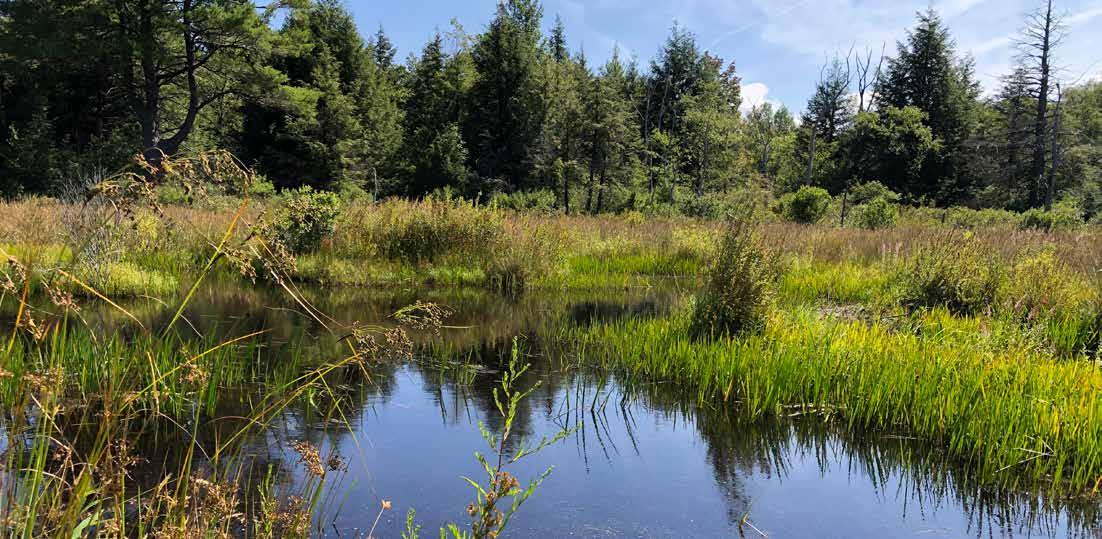
The Babcock Family Nature Reserve, a new 460-acre Conservancy-owned natural area in McKean County, is open to the public for hiking, birding, hunting, fishing, wildlife watching and more.
The Conservancy’s land protection work continues to play a significant role in ensuring that wildlife habitats, including forests, rivers and streams, stay natural, safeguarding the delicate balance of biodiversity in the face of climate change.
NEW CONSERVANCY-OWNED NATURE PRESERVE OPENS
In 2023, the Conservancy protected a total of 3,079 acres, including 460 to establish a new WPC nature preserve in McKean County. Now named the Babcock Family Nature Reserve, it provides a new spot where outdoor and nature enthusiasts can enjoy fishing, hunting and nature observation. Parking and trail access will be added in the future.
This reserve is within the Ormsby Swamp Natural Heritage Area, the large wetland complex that comprises upland forest, shrub thickets, open boggy areas, and several ponds that form the headwaters of Little Black Brook, a tributary to Kinzua Creek. These habitats support several rare species, including two plant, four butterfly and six dragonfly species of conservation concern in Pennsylvania. The Conservancy’s newest preserve is possible thanks to a generous donation from the Babcock Family Charitable Trust and other funders.
Opening to the public in December 2023, the preserve honors the legacy of the Babcock family’s longstanding connection with the Conservancy and commitment to conservation. The family patriarch, Edward Vose Babcock,
was one of the 10 founding members of the Conservancy under its former name, Greater Pittsburgh Parks Association, in 1932. He was also a lumber industrialist who served as Pittsburgh’s mayor from 1918 to 1922. After his passing in 1948, the Babcock family continued their support of the Conservancy’s land protection efforts.
PROTECTING HABITATS AND VIEWSHED IN THE LAUREL HIGHLANDS
Two Laurel Highlands conservation projects closed in 2023 that protect not only wildlife habitats, but preserve the viewshed along the Pennsylvania Turnpike.
In Jefferson Township, Somerset County, 410 acres of steep forested slopes and riparian forest now safeguard water quality and wildlife habitat along Clear Run Creek, a tributary to Laurel Hill Creek. Clear Run Creek, a designated High Quality Coldwater stream by the PA Fish and Boat Commission, supports natural trout production, including for the eastern brook trout. The acres were added to Forbes State Forest.
In Mount Pleasant Township, Westmoreland County, 65 acres will remain intact, thanks to land now permanently protected via a conservation easement, which is a permanent deed restriction
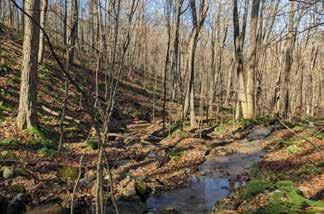
Valley woodland property ensures the protection of a headwater stream to Ninemile Run in Unity Township, Westmoreland County.
on privately owned land to limit some development and mineral extraction.
The Ligonier Valley property hosts a variety of wildlife species, and portions of it are located within the Freeman Falls Natural Heritage Area, a site that hosts rare plants and animals and highquality ecological communities.
Since the 1970s the Conservancy has permanently protected nearly 27,000 acres of land in the Ligonier Valley, of which more than 10,000 are through conservation easements. “This project is a continuation of efforts by the Conservancy to enhance the scenic character of the Ligonier Valley landscape while protecting the rare and important wildlife habitat located there,” explains Conservancy President and CEO Thomas Saunders.

Much of the land the Conservancy protected in 2023 is located in the important riparian zones along river and streams.
In Warren County, 109 acres in Columbus Township were conserved along Brokenstraw Creek, a tributary to the Allegheny River. The acreage was immediately conveyed to the PA Game Commission and is now an addition to State Game Lands 197.
There is now more land in Cameron County for hikers to explore and wildlife to thrive, thanks to the permanent protection of 414 acres of forestland in Gibson Township, which safeguards more than 6,500 feet of frontage along Driftwood Branch Sinnemahoning Creek and contains mountain streams, small wetland areas, old agricultural fields and mature timber stands.
The property was immediately conveyed to the PA Department of Conservation and Natural Resources to become a new addition to Elk State Forest.
More than 130 acres of steep forested slopes and riparian forest along Nine Mile Run in Ulysses Township, Potter County are protected and now part of the surrounding Susquehannock State Forest. The land provides 3,500 feet of riparian
buffer along Nine Mile Run, a tributary to Pine Creek and a PA Fish and Boat Commission Class A Wild Trout Stream. The run is also designated by the PA Department of Environmental Protection as a High Quality Coldwater Fishery. The property also provides important breeding habitat for many bird species, including black-throated green warbler, scarlet tanager, field sparrow, black-throated blue warbler, brown creeper, winter wren and wood thrush.
STORIES PROJECT ADVANCES Conservancy staff continued to work with several partners, including Indiana University of Pennsylvania, to advance an important community effort, the “Untold Stories of Pennsylvania’s State Parks & Forests,” to help discover, interpret and share the untold stories of underrepresented and marginalized groups associated with lands currently operating as state parks and forests in Western Pennsylvania.
In collaboration with DCNR, the Pennsylvania Historical & Museum Commission and other partners, the project will soon provide findings from cultural and historical research. This work will inform storytelling, interpretive education, and historic and prehistoric land acknowledgment and will conclude in 2025.
The Western Pennsylvania Conservancy received support from 11,129 private donors (individuals, corporations, foundations and organizations) that together made cash, stock and in-kind gifts totaling $10,061,302 in 2023. Their extraordinary generosity played a significant role in advancing WPC’s mission of protecting water, land and wildlife in Western Pennsylvania as well as the iconic Frank Lloyd Wright-designed Fallingwater.
We are also delighted to recognize both the generous future commitments of our Heritage Circle members as well as remember the legacies of those who passed on in 2023. Together, they provide transformational support for the Conservancy to care for our beautiful region now and in the future.
Donors making gifts totaling $250 or more, and Evergreen Circle members who gave $100 or more, are listed on the following pages. We regret that space constraints prohibit acknowledging all supporters by name. We have made every effort to ensure that our donor lists are accurate and reflect gifts last year; however, should you find an error or omission, please contact Nicole Walsh, donor stewardship manager, tollfree at 1-866-564-6972 (ext. 2322) or via email at nwalsh@paconserve.org
The Western Pennsylvania Conservancy relies on the support of nearly 11,000 member households and its volunteers to fulfill its mission. Your continued involvement will ensure that our work continues.
The Heritage Circle recognizes donors who have made the Western Pennsylvania Conservancy a part of their legacy through their estate plans. By designating the Conservancy as a beneficiary of a will, trust, IRA, retirement plan, life insurance policy or charitable gift annuity, individuals provide long-term, significant support for the Conservancy. Contact Julie Holmes, senior director of development, toll-free at 1-866-564-6972 (ext. 2312) or jholmes@paconserve.org for more details.
Gifts to the annual fund are essential in sustaining our daily operations. These vital contributions enable the Conservancy to carry out its mission throughout the year. You can also provide dependable income for WPC and Fallingwater by making your annual gift through convenient monthly deductions via credit card or debit from a designated financial account. For more details, contact Kathy Patrignani, development operations administrator, toll-free at 1-866564-6972 (ext. 2340) or via email at kpatrignani@paconserve.org. Additional information can be found on our website at WaterLandLife.org
The Conservancy’s Leadership Circle members, including Kaufmann Society donors whose gifts are designated for Fallingwater, have made the Western Pennsylvania Conservancy’s work a philanthropic priority. Members who make annual gifts of $1,000 or more are recognized through the Leadership Circle
and Kaufmann Society. The Conservancy recognizes this significant commitment by providing enhanced access to our programs, special outings and additional insights into our plans throughout the year. Become a monthly donor and make your $1,000+ annual gift in convenient monthly deductions—a simple way to make a big difference! Contact Julie Holmes, senior director of development, at 412-586-2312 or via email at jholmes@paconserve.org for more information.
Members of the Evergreen Circle have loyally supported the Conservancy for at least 15 out of the last 20 years. Some have been members for much longer —with memberships dating back to the 1950s! Their loyal and continuous support has been a crucial part of our successful work. We are deeply grateful for those who constantly support our efforts each and every year.
Many companies and organizations will match employee contributions, greatly increasing the impact of your gift to WPC. Please contact your human resources office for further information.
The Conservancy deeply appreciates gifts of appreciated stock, real estate property, in-kind gifts and multiyear commitments in support of our programs. Please contact the Conservancy’s development office at 412-586-2336 or development@paconserve.org for more information.
800 Waterfront Drive
Pittsburgh, PA 15222
412-288-2777
info@paconserve.org
WaterLandLife.org
Fallingwater.org
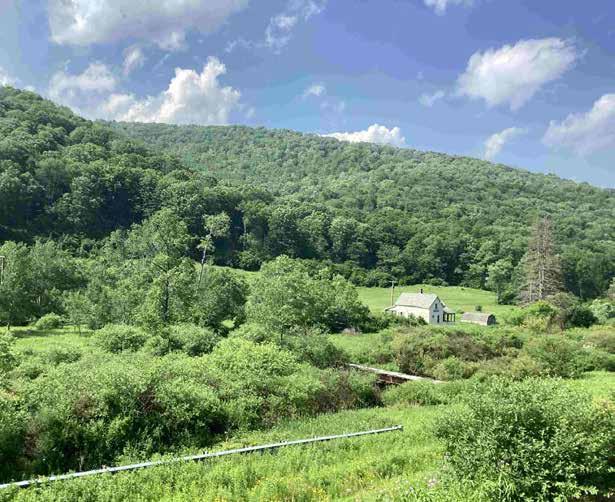
a
You can create a long-lasting impact in Western Pennsylvania by including the Conservancy in your estate plans.
Your legacy will contribute to our financial strength and ability to conserve Western Pennsylvania’s most spectacular land, water and wildlife and to care for Fallingwater, Frank Lloyd Wright’s masterpiece. There are a variety of options, but bequests in a will or trust are one of the most common ways of making a legacy gift, and they are simple to establish!
If you would like more information or if you have already included WPC, or one of its programs such as Fallingwater, in your estate plans, please contact Julie Holmes, senior director of development, at 412-586-2312 or jholmes@paconserve.org.
